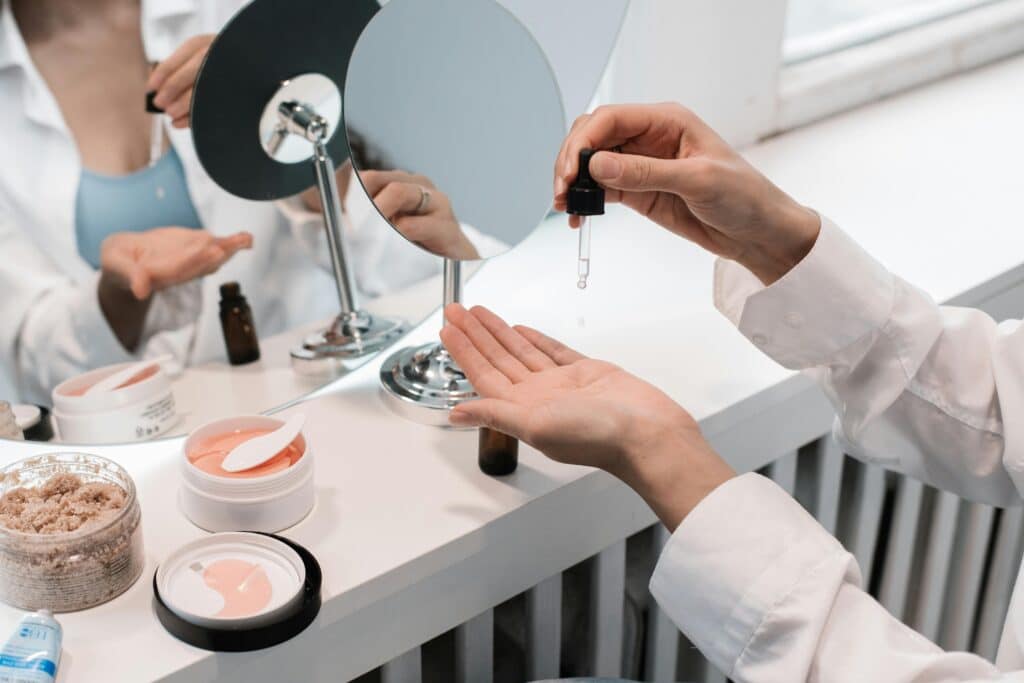When you reach the age of 30, you may notice several changes in your body and health that may be concerning.
For example, wrinkles may start to show on your face due to slow skin cell turnover.
It might also take longer for your body to recover from workouts, and you might experience low energy unlike before.
Moreover, you may also gain more weight and lose muscle mass and bone density.
You might think that aging is the culprit.
However, according to Mayo Clinic, these changes are because of the natural decline of human growth hormone (HGH) that comes with age.
Ipamorelin and sermorelin are two peptides that can stimulate the body’s production of human growth hormone (HGH).
In this article, we compare the two peptides for those interested in taking one or the other to improve HGH and other benefits.
Table of Contents
ToggleWhat is Human Growth Hormone?

Human growth hormone (HGH) is a naturally occurring hormone secreted by the pituitary gland.
It is critical in growth, cell regeneration, and cell reproduction, as it helps to maintain, build, and repair healthy tissue in the brain and organs.
It also helps repair muscle tissue and speed up healing for injury after exercise.
Aside from that, HGH helps grow muscle mass, boost metabolism, and burn fat.
Researchers also believe that it can help slow down the aging process and keep your skin’s appearance as youthful as possible.
However, when you reach age 30, HGH begins to decline, and having lower levels than normal can lead to so-called growth hormone deficiency.
Women with this deficiency have increased body fat, especially around the waist. They experience fatigue and low stamina, have weak bones and muscles, and are at increased risk of heart disease.
Because of this, synthetic human growth hormone has been developed to support healthy HGH levels and avoid the changes linked to aging.
The problem is that most HGH treatments can lead to irreversible acromegaly. It can also result in complications over time such as carpal tunnel syndrome, heart disease, edema, and diabetes.
That’s why we highly recommend using peptides to support healthy human growth hormone levels.
Two of these peptides are sermorelin and ipamorelin.
Sermorelin vs Ipamorelin

Sermorelin and ipamorelin are both excellent choices for boosting HGH production. The question is: which peptide therapy is best?
Sermorelin
Sermorelin, also called sermorelin acetate, is a peptide analog of the human growth hormone-releasing hormone (GHRH).
It contains the first 29 amino acids of GHRH, which consist of 44 amino acid peptides with similar biological activity.
It works by prompting the pituitary gland to boost growth hormone (GH) secretion.
This increases insulin-like growth factor 1 (IGF-1) levels, which helps boost muscle development, enhance wound healing, reduce fat, and regenerate bone.
In 1997, sermorelin was approved by the FDA for the treatment of growth hormone deficiency in children and to increase their height during childhood.
However, in 2008, FDA approval was withdrawn due to issues in safety and efficacy.
Below are some of the top benefits of sermorelin.
A study published in the Journal of Growth Hormone & IGF Research showed that boosting sermorelin is critical in muscle growth and bone health, specifically for treating osteoporosis.
Patients with GHD of juvenile onset have reduced skeletal mineralization.
When substituting GH in patients with GHD, bone turnover is increased and bone mineral density initially decreases during the first year due to the increase in remodeling space.
From the experience in patients with acromegaly, cortical bone mass is increased and trabecular bone mass is normal in eugonadal or decreased in hypogonadal patients.
In patients with GHD of juvenile onset, mineralization and bone maturation are achieved during treatment with GH in adult life after having reached final body height, leading to an increase in bone mass.
The GH/ IGF-I system is dysregulated in patients with postmenopausal osteoporosis.
This is shown by reduced systemic IGF and IGFBP-3-levels in osteoporosis, suggesting a decrease of endogenous GH-secretion or a dysregulation of the GH receptor system that is beyond the normal aging process of the GH/IGF system, the “somatopause.”
Premature somatopause may be responsible for the dysregulation in some patients with osteoporosis.
Another study published in the Proceedings of the National Academy of Sciences showed that sermorelin supports a healthy heart. In fact, it has therapeutic effects on the heart’s function and performance after a heart attack.
GHRH-A markedly improved cardiac function as shown by echocardiographic and hemodynamic parameters. MI size was substantially reduced, whereas myocyte and nonmyocyte mitosis was markedly increased by GHRH-A.
These effects occurred without increases in circulating levels of growth hormone and insulin-like growth factor I and were, at least partially, nullified by GHRH antagonism, confirming a receptor-mediated mechanism.
GHRH-A stimulated CSCs proliferation ex vivo, in a manner offset by MIA-602.
Collectively, our findings reveal the importance of the GHRH-signaling pathway within the heart.
Therapy with GHRH-A, although initiated 1 mo after MI, substantially improved cardiac performance and reduced infarct size, suggesting a regenerative process.
Therefore, activation of GHRHR provides a unique therapeutic approach to reverse remodeling after MI.
Researchers also reported that sermorelin has immune-boosting benefits, according to The Journal of Clinical Endocrinology & Metabolism.
Treatment with GHRH analog resulted in a significant increase (107 and 70% in men and women, respectively) in the 12-h integrated GH secretion in both men and women by 4 weeks and lasted 12 weeks for IGF-I and 16 weeks for GH.
Activation of the immune system occurred in both sexes within 4 weeks.
A 30% increase in lymphocytes expressing the transferrin receptor (CD71) and in monocytes (CD14) occurred within 4 weeks.
By 16 weeks, there was a significant increase (30%) in B cells (CD20) , in cells expressing the T cell receptor alpha/beta (20%), and T cell receptor gamma/delta (40%).
The increase in B cell number was associated with enhanced responsiveness (50%) to the B cell mitogens: pokeweed mitogen (P < .01 or better) and Staphylococus aureus cells (P < .001), and a transient increase at 4 weeks in circulating IgG (P < .0001), IgM, and IgA (P < .001).
T cells were functionally activated, as evidenced by a 50% increase in responsiveness to phytohemagglutinin, 70% increase in the number of lymphocytes expressing the IL-2 receptor (IL-2R) (CD25) (P < .001), and enhanced IL-2R messenger RNA expression and basal IL-2 secretion (50%) (P < .05) at 16 weeks of treatment. Furthermore, the circulating soluble IL-2 receptor rose significantly (15%) (P < .05) within 4 weeks of treatment and remained elevated for the duration of the study.
Not only that, but taking sermorelin weekly can also help reduce abdominal fat mass.
Participants were 26 adults aged 40-65 years old with abdominal obesity.
The subjects were given 3 mg of SR-rhGH, administered subcutaneously, weekly for 26 weeks. SR-rhGH treatment for 26 weeks increased the IGF-1 level by 56.53±76.09 μg/l (SDS 0.77±1.12) compared to the baseline (p=0.0022).
After 26 weeks, SR-rhGH treatment reduced abdominal visceral adipose tissue (VAT) (140.35±75.97 to 128.43±73.85 cm2, p=0.0038).
Average waist circumference decreased from 96.25±6.41 to 91.93±6.13 cm after treatment.
In conclusion, SR-rhGH treatment for 26 weeks reduced abdominal visceral fat and waist circumference without severe adverse events.
Lastly, adults who used sermorelin were able to experience improved memory, learning, and brain function.
The intent-to-treat analysis indicated a favorable effect of GHRH on cognition, which was comparable in adults with MCI and healthy older adults.
Subsequent analyses indicated a positive GHRH effect on executive function and a trend showing a similar treatment-related benefit in verbal memory.
Treatment with GHRH increased insulin-like growth factor 1 level by 117 %, which remained within the physiological range, and reduced percent body fat by 7.4% .
Treatment with GHRH increased fasting insulin levels within the normal range by 35% in adults with MCI but not in healthy adults.
Adverse events were mild and were reported by 68% of GHRH-treated adults and 36% of those who received the placebo.
20 weeks of GHRH administration had favorable effects on cognition in both adults with MCI and healthy older adults.
You can take sermorelin via injection. According to a study published in JCSM Rapid Communications, HGH release after taking sermorelin peptide can happen within 12 minutes.
Ipamorelin
Ipamorelin is a pentapeptide that displays growth hormone-releasing potency and efficacy.
This growth hormone-releasing peptide (GHRP) or growth hormone secretagogue mimics the hunger hormone, ghrelin.
When bound in brain receptors, it triggers the pituitary gland to release and produce more human growth hormone.
Ipamorelin is considered one of the safest and most effective forms of growth hormone replacement therapy, as it does not affect the release of aldosterone, acetylcholine, prolactin, or cortisol in the body.
No wonder why it’s one of the most popular peptides to help with aging, muscle growth, fat loss, and enhancing sports performance.
Below are some of the top benefits of using ipamorelin.
Using ipamorelin helps boost collagen levels and promote muscle regeneration, improving muscle mass.
Increased expression of myogenic marker proteins was observed in GHRP-6-biotin conjugate-treated cells. Additionally, increased expression levels of insulin-like growth factor-1 and collagen type I were observed.
Furthermore, GHRP-6-biotin conjugate-treated cells showed increased metabolic activity, as indicated by increased concentrations of energy metabolites, such as ATP and lactate, and increased enzymatic activity of lactate dehydrogenase and creatine kinase.
Finally, binding protein analysis suggested a few candidate proteins, including desmin, actin, and zinc finger protein 691, as potential targets for GHRP6-biotin conjugate action.
These results suggest that the newly synthesized GHRP-6-biotin conjugate has myogenic stimulating activity by, at least in part, stimulating collagen type I synthesis and several key proteins.
It can also help improve cardiac output and ventricular mechanical work in patients with heart disease, according to The New England Journal of Medicine.
When administered at a dose of 14 IU per week, growth hormone doubled the serum concentrations of insulin-like growth factor I. Growth hormone increased left ventricular wall thickness and reduced chamber size significantly.
Consequently, end-systolic wall stress (a function of both wall thickness and chamber size) fell markedly (from a mean [+/-SE] of 144+/-11 to 85+/-8 dyn per square centimeter, P<0.001).
Growth hormone improved cardiac output, particularly during exercise (from 7.4+/-0.7 to 9.7+/-0.9 liters per minute, P=0.003), and enhanced ventricular work, despite reductions in myocardial oxygen consumption (from 56+/-6 to 39+/-5 ml per minute, P=0.005) and energy production (from 1014+/-100 to 701+/-80 J per minute, P=0.002).
Thus, ventricular mechanical efficiency rose from 9+/-2 to 21+/-5 percent (P=0.006). Growth hormone also improved clinical symptoms, exercise capacity, and the patient’s quality of life.
The changes in cardiac size and shape, systolic function, and exercise tolerance were partially reversed three months after growth hormone was discontinued.
In another study published in The Journal of Clinical Endocrinology and Metabolism, researchers reported that ipamorelin helps boost GH secretion, improving blood sugar levels in diabetic patients.
Each subject received GHRH (100 microg iv), GHRP-6 (90 microg iv), and GHRH plus GHRP-6 on three separate days.
GH peak values were higher in DM 1 patients than in control volunteers after GHRH (52.2+/-9.8 vs. 19.3+/-6.0 microg/L; P = 0.016), GHRP-6 (66.2+/-9.6 vs. 39.9+/-6.3 microg/L; P = 0.05), and GHRH plus GHRP-6 (81.8+/-4.4 vs. 53.7+/-8.2 microg/L; P = 0.01).
An additive GH response to the combined administration of these two peptides was observed in diabetic patients. Serum insulin-like growth factor (IGF)-1 levels were diminished in DM 1 with respect to normal subjects (145.2+/-21.5 vs. 269.7+/-42.0 microg/L; P = 0.01), whereas IGF-binding protein-3 levels were not significantly different between DM-1 and controls.
It can also help boost white blood cells, T cells, and B cell levels of the immune system, based on a study published in The Journal of Pediatrics.
In as much as growth hormone is known to interact with the immune system, we studied immune functions including immunoglobulins, cell surface markers, mitogen responses, and polymorphonuclear cell function in eight children with growth hormone deficiency, ages 1 to 17 years, before and during treatment with human growth hormone for 12 to 16 months.
Before treatment, immune functions were normal in all children. Treatment with human growth hormone did not significantly affect serum immunoglobulins, polymorphonuclear cell function, or percent T cells.
However, percent B cells decreased to subnormal levels in seven of seven patients. T helper/suppressor ratios decreased in all patients to subnormal values in seven of eight patients, and mitogen responses decreased to below normal in all.
The decline of percent B cells was transient in all patients, of T helper/suppressor ratios in seven of eight, and mitogen responses in five of eight patients.
In vitro incubation of lymphocytes with growth hormone resulted in no changes in cell surface markers or mitogen responses.
Ipamorelin also helps prevent cognitive decline by protecting brain cells from cell death.
Treatment of adult male rats with GHRP-6 or GH for 1 week significantly increased IGF-I mRNA levels in the hypothalamus, cerebellum, and hippocampus, with no effect in the cerebral cortex.
Expression of the IGF receptor and IGF-binding protein (IGFBP)-2 were not affected.
Phosphorylation of Akt and Bad was stimulated in areas where IGF-I was increased, with no change in MAPK or glycogen synthase kinase-3beta.
This suggests that GH and GHRP-6 activate phosphatidylinositol kinase intracellular pathways involved in cell survival in response to growth factors. Indeed, the antiapoptotic protein Bcl-2 was augmented in these same areas, with no change in the proapoptotic protein Bax.
IGFBP-5, also reported to be involved in neuron survival processes, was increased mainly in the hypothalamus, suggesting a possible neuroendocrine role.
Lastly, this peptide also slightly increases estrogen and testosterone levels, improving desire, sexual thoughts, and functions in men and women taking ipamorelin.
GH increased testosterone and oestradiol secretions in a dose-dependent manner.
While testosterone secretion reached the saturation point with 50 ng GH, oestradiol secretion reached the saturation point with 150 ng GH, followed by diminished secretions.
Co-administration of minimum (10 ng) effective doses of GH with minimum (25 ng) or maximum (100 ng) effective doses of oLH significantly decreased testosterone secretion.
However, an increased secretion of testosterone was observed when maximum effective doses of rGH (50 ng) and oLH (100 ng) were co-administered.
Oestradiol concentration in the culture medium increased when either dose of rGH was co-administered with the minimum or maximum effective doses of oLH. T3 50 ng augmented the secretion of oestradiol by Leydig cells in the presence of GH.
Compared to sermorelin, ipamorelin is not yet approved by the FDA.
Ipamorelin is best administered subcutaneously as it stimulates GHRH release for up to 30 minutes.
Ipamorelin vs Sermorelin: Which is better?

Here’s what we know: ipamorelin and sermorelin have similar effects — they can stimulate the natural secretion of growth hormone — but they do it in slightly different ways.
Below, we sum up the subtle differences between these two anti-aging peptides.
Genetic Makeup
Ipamorelin contains few amino acids, which is why it’s available in several forms.
In contrast, sermorelin is a larger peptide composed of 29 amino acid blocks.
Effects on HGH
Sermorelin stimulates the pituitary gland to secrete HGH, boosting insulin-like growth factor (IGF-1) levels.
The increase in IGF-1 levels improves metabolism and cellular growth.
On the other hand, ipamorelin works by mimicking ghrelin actions in the body.
It binds to ghrelin receptors in the brain, resulting in the stimulation of the pituitary gland to release HGH.
Sermorelin Prolongs HGH
Sermorelin helps sustain HGH levels, supporting a consistent balance throughout the day. This prolonged release of HGH is critical because the body does not secrete HGH at regular intervals.
On the other hand, ipamorelin results in a rapid increase in HGH levels with a shorter half-life.
Since HGH secretion occurs at night, your diet and stress can hinder its release, reducing its benefits.
Administration
Both sermorelin and ipamorelin are optimally dosed as a subcutaneous injection.
Stimulation
Sermorelin stimulates the brain to release GHRH for about 10-12 minutes, while ipamorelin and cjc-1295/ipamorelin stimulate GHRH release for up to 30 minutes.
Clinical Trials and FDA Approval
In 1997, sermorelin was initially approved by the FDA for children and adult use.
However, it was withdrawn in 2008 due to safety and efficacy issues.
Ipamorelin has yet to be approved by the FDA.
How Much Ipamorelin or Sermorelin Should You Take?

You can take 300 mcg of sermorelin or ipamorelin injections per day.
In some cases, you can take them once or twice daily between 250/100 mcg to 500/200 mcg right before bed per administration.
Results may vary, but you can see and experience the health benefits within 3 to 6 months of consistently taking them at these dosages.
Sermorelin and Ipamorelin: The Takeaway

If you’re looking to boost your energy, lose fat, and feel your best even as you age, both ipamorelin and sermorelin are great peptide options to support healthy HGH levels.
They both also have strong track records of safety and efficacy.
In Jay’s personal experience working with thousands of people using Peptides, Ipamorelin is hands down his favorite peptide for women when used in isolation.
Ipamorelin is also the most effective for men and women when used over time due to its ability to never disturb the bodies natural production of hGH.
Eating an insulin controlled diet while engaging in regular exercise, along with taking either Ipamorelin or Sermorelin, will surely allow you to experience optimal results over time.
If you’re in search of the safest, purest, and third-party tested Ipamorelin available…
We recommend Limitless Life Nootropics, as they have some of the best formulations of Ipamorelin on the market.
That’s not to mention Limitless offers the BEST deals on both price and peptide purity.
Use code JAY15 at the checkout cart for 15% off!
But before you start injecting these two peptides into your body recklessly, make sure you first read the Top 10 Mistakes People Make When Starting Therapeutic Peptides FREE PDF!
Seriously, this short e-book will save you a lot of wasted money and poorly spent time (not to mention preventing you from potential self-inflicted injuries).
And the emails I’ll send you after downloading the book contain an EXCLUSIVE 33% OFF code for my Peptides Demystified Course, so don’t miss out!
Raise Your Vibration To Optimize Your Love Creation!
PS — Are you gaining weight, starting to show wrinkles on your face, or experiencing low energy?
Join me and other biohackers in The Fully Optimized Health Private Membership Group to learn how you can use peptides, especially sermorelin and ipamorelin, to optimize your health in your 30s and beyond.
We’re excited to discuss biohacking, health, and life optimization through peptide therapy with you. See you on the other side!



